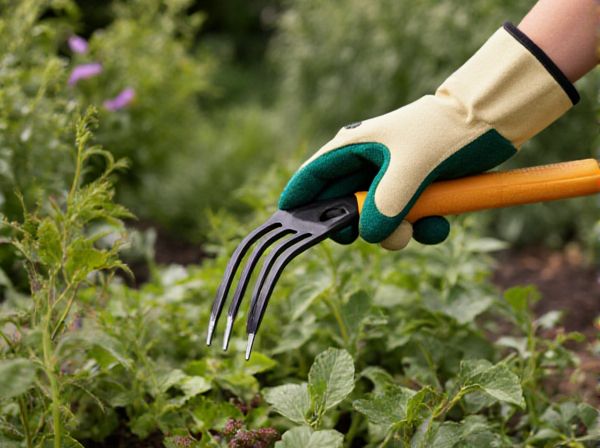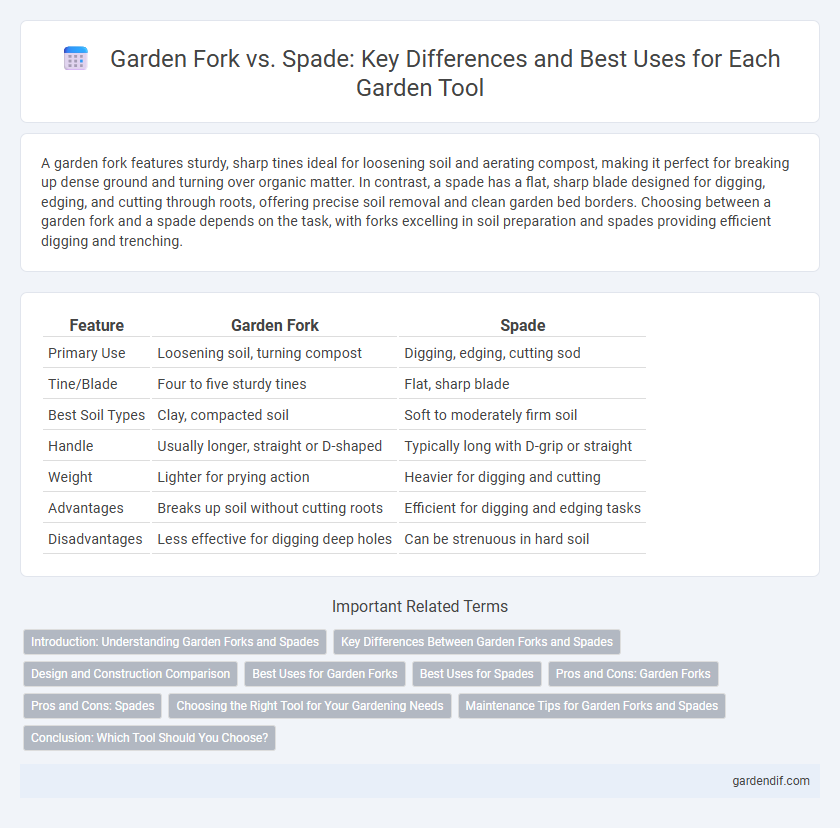
Garden fork vs Spade Illustration
A garden fork features sturdy, sharp tines ideal for loosening soil and aerating compost, making it perfect for breaking up dense ground and turning over organic matter. In contrast, a spade has a flat, sharp blade designed for digging, edging, and cutting through roots, offering precise soil removal and clean garden bed borders. Choosing between a garden fork and a spade depends on the task, with forks excelling in soil preparation and spades providing efficient digging and trenching.
Table of Comparison
| Feature | Garden Fork | Spade |
|---|---|---|
| Primary Use | Loosening soil, turning compost | Digging, edging, cutting sod |
| Tine/Blade | Four to five sturdy tines | Flat, sharp blade |
| Best Soil Types | Clay, compacted soil | Soft to moderately firm soil |
| Handle | Usually longer, straight or D-shaped | Typically long with D-grip or straight |
| Weight | Lighter for prying action | Heavier for digging and cutting |
| Advantages | Breaks up soil without cutting roots | Efficient for digging and edging tasks |
| Disadvantages | Less effective for digging deep holes | Can be strenuous in hard soil |
Introduction: Understanding Garden Forks and Spades
Garden forks, also known as digging forks, feature strong, sturdy tines designed to loosen, lift, and turn soil without damaging plant roots. Spades have a flat, sharp blade ideal for cutting through soil, edging, digging, and transplanting tasks with precision. Understanding the distinct uses and structural differences of garden forks and spades enhances efficiency in gardening and soil management.
Key Differences Between Garden Forks and Spades
Garden forks feature multiple sturdy tines designed for loosening and aerating soil without cutting through roots, making them ideal for breaking up compacted earth and lifting root crops. Spades have a flat, sharp-edged blade optimized for digging, edging, and slicing through sod or soil, providing precision in cutting and transferring soil. The key difference lies in their function and design: garden forks penetrate and lift soil layers, while spades cut and dig efficiently.
Design and Construction Comparison
Garden forks feature four to five sturdy, slightly curved tines made of heat-treated steel, optimized for aerating soil and lifting heavy clumps. Spades have a flat, rectangular blade crafted from tempered steel, designed for digging and edging with precision. The garden fork's handle typically includes a D-shaped grip for leverage, whereas the spade often has a straight or slightly curved long handle for added digging force.
Best Uses for Garden Forks
Garden forks excel at loosening, lifting, and turning over heavy soil without compacting it, making them ideal for preparing beds and aerating compost piles. Their sturdy tines penetrate dense ground, breaking up clumps and allowing better water and nutrient absorption for plant roots. Unlike spades, garden forks are perfect for harvesting root vegetables and removing perennial weeds with minimal soil disturbance.
Best Uses for Spades
Spades are best used for digging, edging, and lifting sod or soil due to their flat, sharp blades that penetrate the ground efficiently. Their design allows for precise cutting of roots and compacted soil, making them ideal for transplanting and creating clean garden beds. Compared to garden forks, spades excel in tasks requiring smooth, straight cuts and defined edges.
Pros and Cons: Garden Forks
Garden forks offer superior soil aeration and are ideal for breaking up compacted earth and lifting root crops without damaging them. Their sturdy, spaced tines make turning heavy or rocky soil easier but can struggle in sandy or loose soil where a spade might be more efficient. Garden forks are less effective for edging or precise digging, tasks where a spade excels due to its flat, sharp blade.
Pros and Cons: Spades
Spades offer excellent soil penetration and are ideal for digging straight-edged trenches and edging garden beds due to their flat, sharp blade. Their rigid, sturdy design provides durability and leverage for breaking hard ground but can be heavy and less efficient for turning over large amounts of soil compared to garden forks. Spades require more effort to maneuver in rocky or compacted soil, which may limit their use in some gardening tasks.
Choosing the Right Tool for Your Gardening Needs
A garden fork is ideal for loosening, lifting, and turning soil without damaging plant roots, making it perfect for aerating heavy clay or compacted ground. A spade excels in digging, edging, and slicing through sod or root-bound soil, offering precision for planting and transplanting tasks. Selecting the right tool depends on soil type, gardening task, and desired control for efficient and effective garden maintenance.
Maintenance Tips for Garden Forks and Spades
Proper maintenance of garden forks and spades involves regular cleaning to remove soil and moisture, preventing rust and corrosion. Sharpen spade blades periodically with a file to ensure efficient digging, while garden fork tines benefit from occasional straightening and inspection for damage. Storing tools in a dry place and applying a thin coat of oil on metal parts prolongs their lifespan and performance.
Conclusion: Which Tool Should You Choose?
Choosing between a garden fork and a spade depends on the specific gardening task and soil type; garden forks excel at loosening heavy, compacted soil and aerating, while spades are ideal for digging, edging, and cutting through roots. For gardeners handling rocky or clay-heavy ground, a garden fork provides better leverage and reduces strain, whereas spades offer precision for transplanting and shaping garden beds. Evaluating your garden's soil conditions and planting needs ensures selecting the most efficient tool for optimal gardening results.
Garden fork vs Spade Infographic

 gardendif.com
gardendif.com